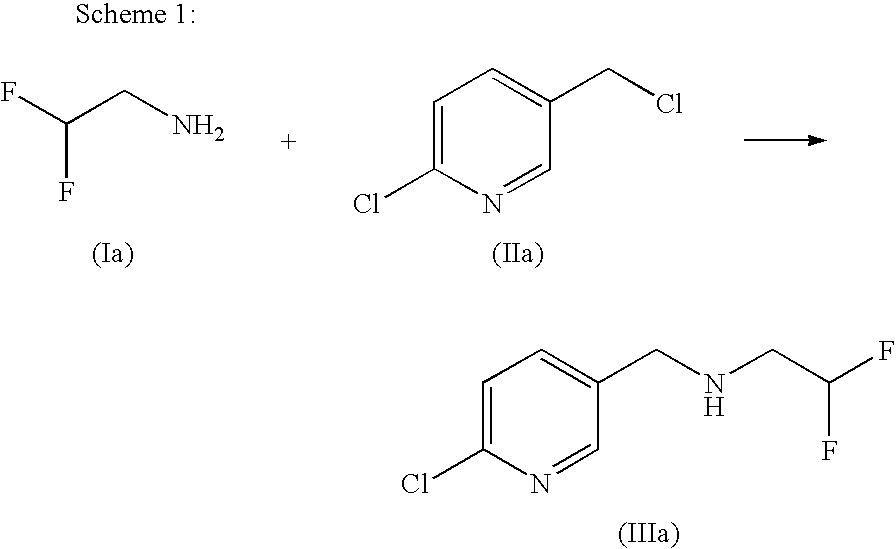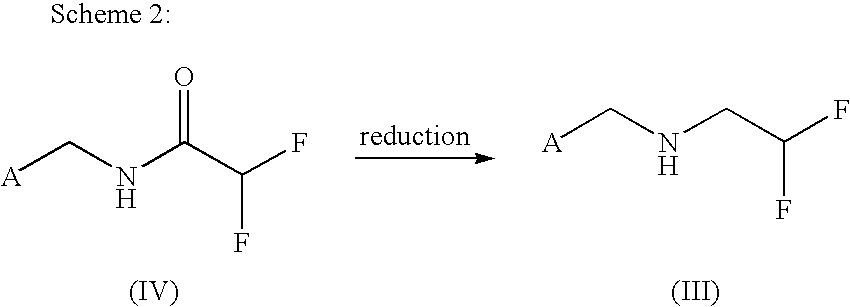Method for producing 2,2-difluoroethylamine derivative by amide hydrogenation
a technology of amide hydrogenation and difluoroethylamine, which is applied in the preparation of amino compounds, organic chemistry, chemistry apparatus and processes, etc., can solve the problems of low yield of 53%, uneconomic, and the proportion of polyalkylation can only be reduced, and achieves simple and inexpensive performance, high purity, and high yield
- Summary
- Abstract
- Description
- Claims
- Application Information
AI Technical Summary
Benefits of technology
Problems solved by technology
Method used
Image
Examples
preparation examples
Example 1
[0092]
[0093]An initial charge of 124 g (1 mol) of ethyl 1,1-difluoroacetate is admixed with 142.6 g of 2-chloro-5-aminomethylpyridine. The reaction mixture is heated to 100° C. and boiled under reflux for one hour. After the cooling has been switched off, the ethanol formed is distilled over. Towards the end of the reaction, to fully remove the ethanol, the mixture is heated up to a bottom temperature of 115° C. or a gentle vacuum is applied. In the reaction flask, there remain 221 g of 99% amide (99% of theory), which solidifies at about 90° C.
[0094]NMR (d-DMSO): NH (br s, 9.4 ppm); 1H (s, 8.35 ppm); 1H (d, 7.75 ppm); 1H (d, 7.5 ppm); 1H (t, 6.1-6.4 ppm); 2H (s, 4.4 ppm).
example 2
[0095]
[0096]22.6 g (0.1 mol) of N-(2-chloro-5-aminomethylpyridine)-1,1-difluoroacetamide are initially charged in 200 ml of THF after addition of 1 g of RhCl3.3 H2O. Then 21 g of phenylsilane are added and stirring is continued until conversion is complete. Thereafter, the mixture is admixed with 1 N hydrochloric acid and extracted with diethyl ether. The aqueous phase is alkalized with 15% sodium hydroxide solution and extracted with diethyl ether. After drying over Na2SO4, the solvent is distilled off under reduced pressure. There remain 20 g of 98% amine (95% of theory).
[0097]NMR(d-DMSO): 1H (s, 8.35 ppm); 1H (d, 7.8 ppm); 1H (d, 7.46 ppm); 1H (td, 6.02 ppm); 2H (s, 3.8 ppm); 2H (td, 2.9 ppm)
example 3
[0098]
[0099]20 g (0.091 mol) of N-(2-chloro-5-aminomethylpyridine)-1,1-difluoroacetamide are initially charged in 200 ml of THF. After the addition of 6.86 g of NaBH4, the mixture is cooled to 0 to 5° C., and 34.3 g of BF3.etherate are added dropwise. The mixture is stirred at 0 to 5° C. overnight. For workup, ethanol and then dilute hydrochloric acid are added dropwise, and the mixture is stirred for a few more hours. After the majority of THF has been distilled off under reduced pressure, the water phase is extracted with ether. The aqueous phase is adjusted to pH 12 with 15% sodium hydroxide solution and extracted twice with diethyl ether. After drying over Na2SO4, the solvent is distilled off under reduced pressure. There remain 17.75 g of 95% amine (90% of theory).
[0100]NMR data: see Example 2
PUM
| Property | Measurement | Unit |
|---|---|---|
| temperatures | aaaaa | aaaaa |
| temperatures | aaaaa | aaaaa |
| pH | aaaaa | aaaaa |
Abstract
Description
Claims
Application Information
 Login to View More
Login to View More - R&D
- Intellectual Property
- Life Sciences
- Materials
- Tech Scout
- Unparalleled Data Quality
- Higher Quality Content
- 60% Fewer Hallucinations
Browse by: Latest US Patents, China's latest patents, Technical Efficacy Thesaurus, Application Domain, Technology Topic, Popular Technical Reports.
© 2025 PatSnap. All rights reserved.Legal|Privacy policy|Modern Slavery Act Transparency Statement|Sitemap|About US| Contact US: help@patsnap.com



